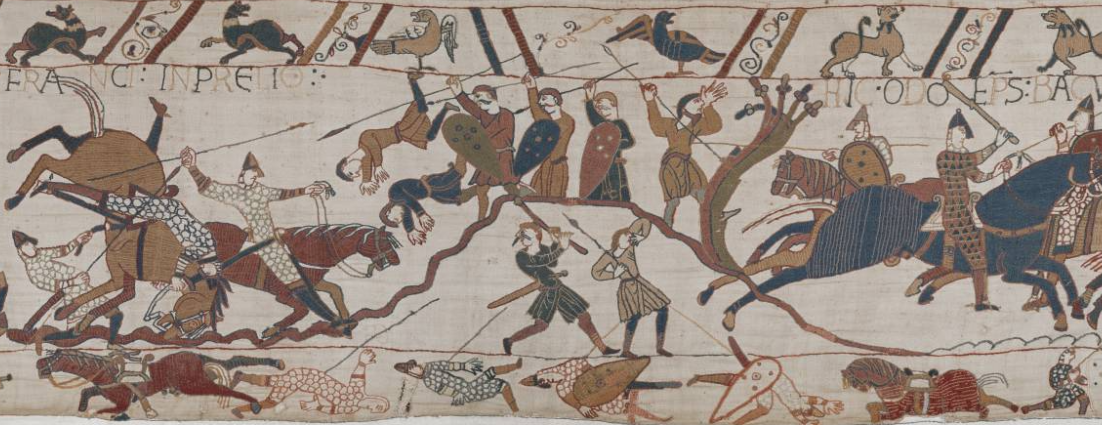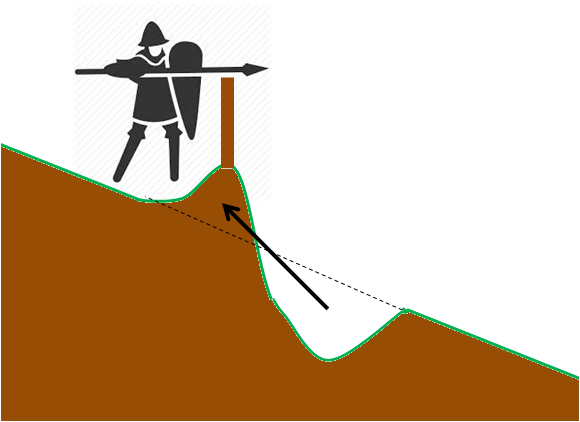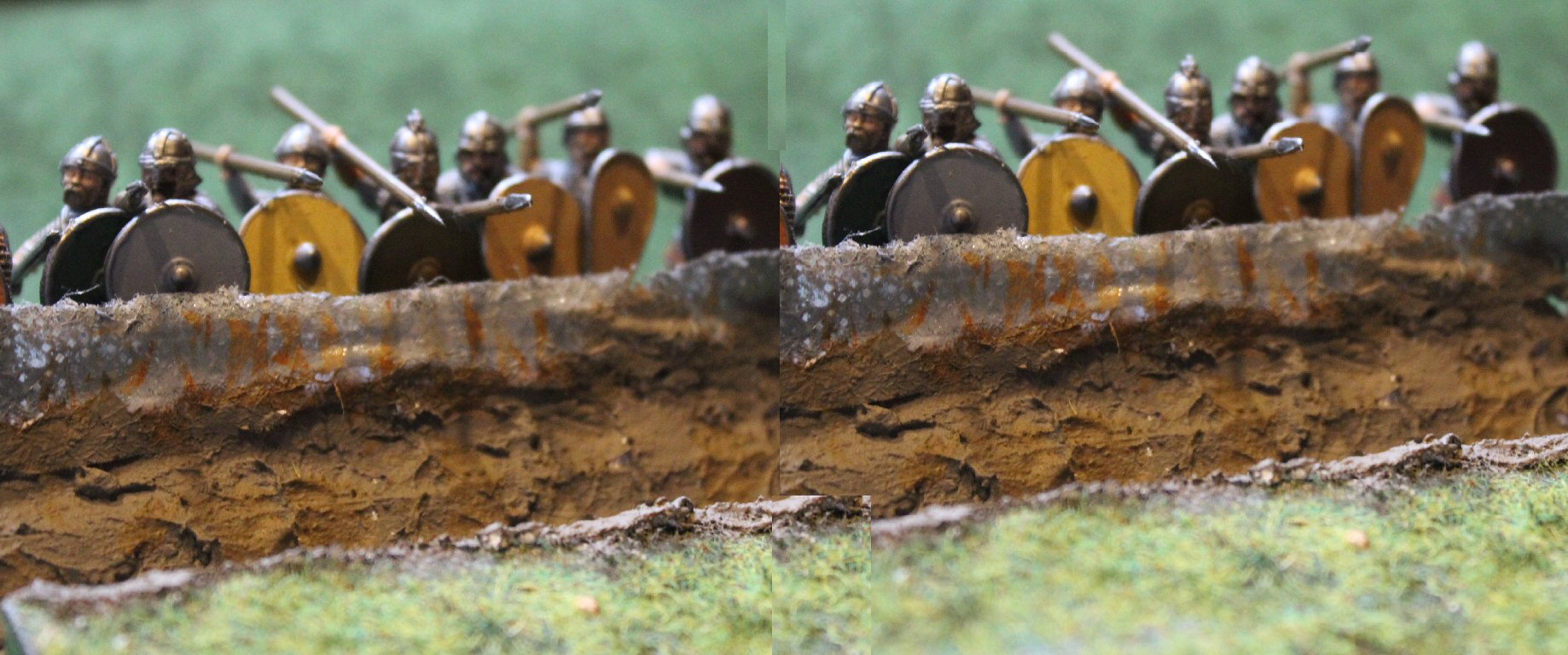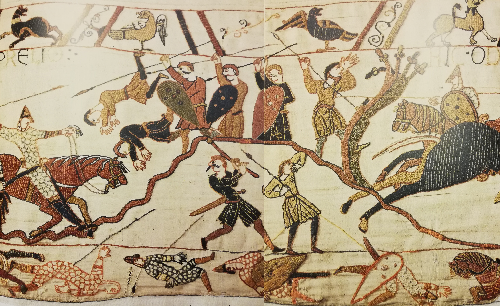|
 | Anglo Saxon History |  | |
| | Battle of Hastings 1066AD - Q - Evidence for the Malfosse |
|---|
| | The Malfosse - Did it exist and what was it ? |
|---|
The term the Malfosse was added to the details of the Battle of Hastings from the Chronicles of Battle Abbey.
This originated from the following:
Quod quidem baratrum sortito ex accidenti uocabulo Malfosse hodieque nuncupatu
Which translates roughly to:
This ditch has been named for the accident, and today it is called Malfosse.
From the documentation it would seem that there could have been two malfosse's or malfossei, one during the battle and a
second while chasing the retreating Saxons.
A military defininition of Fossé (Fr.) is an exterior ditch fronting a rampart or curtain.
| | Documentary evidence ▲ |
|---|
William of Jumièges
However confidence returned to the fugitives when they found a good chance to renew the battle, thanks to a broken
rampart and labyrinth of ditches.
Recorded as the Saxons flee
Orderic Vitalis
(The Normans, finding the English completely routed, pursued them vigorously all Sunday night, but not without
suffering a great loss ; for, galloping onward in hot pursuit, they fell unawares, horses and armour, into an ancient
trench, overgrown and concealed by rank grass, and men in their armour and horses rolling over each other, were crushed
and smothered. This accident restored confidence to the routed English, for, perceiving the advantage given them by the
mouldering rampart and a succession of ditches, they rallied in a body, and, making a sudden stand, caused the Normans
severe loss.)
This again records that the malfosse was after the battle
The second part of this account could apply to the battle and not the rout as routing soldiers do not usually reform as
their units are broken up and spread out by the rout.
Master Wace
(and they had moreover made a fosse, which went across the field),
this is a possibility if the Normans broke through the Shield Wall and hence into the Saxon
lines, but were then pushed back into the ditch(fosse) great losses would have occurred.
Before the battle Master Wace also describes Saxon defences
(There he said he would defend himself against whoever should seek him ; and he had the place well examined, and
surrounded it by a good fosse, leaving an entrance on each of three sides, which were ordered to be all well
guarded.)
In his section on THE ROLL OF THE NORMAN LORDS
(And now might be heard the loud clang and cry of battle, and the clashing of lances. The English stood firm in
their barricades, and shivered the lances, beating them into pieces with their bills and maces. The Normans drew their
swords and hewed down the barricades, and the English in great trouble fell back upon their standard, where were
collected the maimed and wounded.)
claiming that this was a Saxon made defence this potentially explains the battle ditch
description.
Henry of Huntingdon
(But Harold had formed his whole army in close column, making a rampart that the Normans could not penetrate.
Duke William therefore commanded his troops to make a feigned retreat. In their flight they they happened unawares of a
deep trench which was treacherously covered into which numbers fell and perished. While the English were engaged in
pursuit, the main body of the Normans broke the centre of the enemy's line, which being perceived by those in pursuit
over the concealed trench, when they were consequently recalled most of them fell there.)
This sounds like the Normans attacked a defensive ditch, broke over the rampart then into the
Saxon line, then were pushed back into the ditch and finally routed, the English then followed up but they were also cut
down by the cavalry while pursuing the routed Norman men-at-arms.
Florence of Worcester
(before a third of his army was in fighting order. He gave them battle at a place nine miles from Hastings, where
they had built a fort. The English being crowded in a confined position)
from this account
it would seem that Harold had built a fort as the English were in a confined position, which could be a ditch on three
sides as described by Master Wace(above).
The Chronicles of Battle Abbey
(here lay between the hostile armies a certain dreadful precipice, caused either by a natural chasm of the earth,
or by some convulsion of the elements. It was of considerable extent, and being overgrown with bushes or brambles was
not very easily seen, and great numbers of men — principally Normans in pursuit of the English — were suffocated in
it).
This appears to record that the Malfosse was in the Battlefield, however it could be read as
after the battle.
The Bayeux Tapestry has a scene where horses are seen vertically and a very rough piece of ground goes up to
the Saxon positions, this could also be interpreted as a ditch in front of the Saxon lines with men and horses falling
into it. A further interesting part of this image is that the legs of the Saxons at the top of the hill are behind the
hilltop which could be interpreted as defensive shieldwall above the fosse.
| | The Norman cavalry attack on the hill and the falling horses ▲ |
|---|
Please click the image below to go to the official Bayeux website.

| | There are a few very important facts that need to be looked at ▲ |
|---|
- Harolds army was in the majority the Fyrð who were mostly farm laborers used to digging and fence laying.
- The Fyrð would not have had training or experience against cavalry.
- Fighting against a large force of cavalry is difficult without physical defenses.
- Breton Cavalry were looked on at the time as the best cavalry in Europe.
- A Shield wall(Testudo) requires training to ensure solidity but easily breaks once a gap appears.
- In an open battle cavalry generally massacre infantry due to their mobility.
- Cavalry attacking a Shield wall(Testudo) would attack a single point and break through.
- The battle took place from morning till dusk and would appear to be stalemate until afternoon.
- A number of the reports say that the malfosse was hidden or concealed
- routing troops dont usually have time or energy to prepare traps implying the ditch was in place before the
battle.
- A Shield wall(Testudo) requires close fitting shields and training, neither of which the Fyrð had access
to.
Let us for a moment assume that Master Wace's descriptions was accurate, then we would have a ditch dug around the Saxon
camp with the soil thrown up on the Saxon side, wattles, wood and branches would be woven along the top and the
shieldwall stood behind the wattle fence, this would make it difficult for the cavalry to cross the ditch and attack the
shieldwall, so negating the cavalry's mobility advantage.
Breton Cavalry tactics:
In the Battle of Jengland 851AD King Charles of the Franks arranged his troops in two lines: at the rear were the
Franks; in front were Saxon mercenaries whose role was to break the assault of the Breton cavalry, which was known for
its mobility and tenacity. In the initial engagement, a javelin assault forced Saxons to retreat behind the more heavily
armoured Frankish line. Rather than engage in a melée, the Bretons harassed the heavily armed Franks from a distance,
in a manner comparable to Parthian tactics, but with javelins rather than archers. They alternated furious charges,
feints, and sudden withdrawals, drawing out the Franks and encircling over-extended groups, needlesss to say the Franks
were defeated.
Battle of Jengland AD851 - implies a quick defeat for Harold at
Hastings 1066AD
If the Bretons could defeat the Franks on flat land where the Franks were well armoured, why couldn't
they easily defeat the Saxon Fyrð who were much more lightly armoured unless they were behind defensive
works.
| | Illustrations of a defensive fosse ▲ |
|---|
 | 
|
| Fosse construction | Fyrð behind the shieldwall |
|
Close up of the Bayeux hill attack ▲
|
|---|

This is a closer view of the details of Senlac Hill from the Bayeux Tapestry showing either very uneven ground, or
ditches such as those found on an ancient hillfort.
| | What effect could a military fosse have on the battle ▲ |
|---|
- The Normans would be forced to attack
(The Normans attacked the Saxons)
- The shieldwall would last a long time and only break with weight of numbers in one place
(The Shieldwall appeared to stay formed until the afternoon)
- The Norman archers would have to fire high in the air to hit the Saxons
(The reports are that William ordered the archers to fire high up)
- The Norman cavalry would have to throw spears until the infantry broke through
(The Shieldwall appeared to stay formed until the afternoon)
- If the Normans broke through then were pushed back large number would be killed in the Fosse
(The Normans appeared to break through the Saxon lines but were pushed back)
- If the Normans were pushed back a rout was likely
(The Normans routed but William rallied the troops)
- If the Saxons followed up the rout then the wall would be weakend
(The Saxons followed up, were cut down then the Normans started to break the
shieldwall)
- The malfosse could be concealed by branches etc from the wood used to build the wattle fence
(The Normans lost cavalry in the Malfosse which could have been concealed)
- The Breton cavalry couldn't break through the shieldwall
(If they had been able to use their normal tactics the Saxon Fyrð would have been cut
down)
| | |
|---|
| Could the Saxons have built a Fosse in time ▲ |
|---|
A friend of mine has asked if the Saxons had time to prepare these earthworks prior to the Battle
so I will investigate
Firstly we need to know how long it takes to build a defensive fosse:
There is evidence from the Roman army, of building marching camp ditches 2 mtr in length x 1 mtr deep x 2.5 mtr wide
with a 1 metre tall wall/fence on top of the spoil of taking about 3 hours with 8 builders, so a 100 metre defence would
take 400 men about 3 hours to build, and this would have to be during daylight which in October 1066 was sunrise 05:56
and sunset 17:51, hence would need to be started about 14:00.
Please refer to the following Early Imperial Roman army
campaigning: the building of marching camps.
If you look at the spreadsheet the calculations show that a 5000 marching Roman force, if all men help out, can dig a
rectangular surrounding defense in 3 hours that would enclose the whole unit, this caculation allows for different
arrival times of the troops as they reach the campsite.
The Saxon Fyrð would not have been so well trained so would take longer and would need more supervision probably
from Thegn's and Huscarls, but even so may not have taken more than about 4 hours for defences on three sides to be
created, whatever the size of the force.
Did the Saxons arrive in time to build a fosse:
Anglo Saxon Chronicles William, however, came against him unawares, ere his army was collected; but the
king, nevertheless, very hardly encountered him with the men that would support him: and there was a great slaughter
made on either side.
Battle Abbey Chronicles Harold, the usurper of the kingdom, hearing of his arrival, quickly collected his
army, resolved upon driving out the duke, or rather upon utterly destroying him and his, and marched forward, with great
boldness and expedition, to the place which is now called Battel, where the duke, surrounded by his battalions of
cavalry, met him courageously.
The duke, then, by his heralds, thrice offered conditions of peace, which were thrice refused by the enemy; and at
length, conformably to the prophecy of Merlin a Norman race in iron coats boldly cast down the pride of the English.
Master Wace states that Harold arrived and setup the base, then the following day reconnoitered the Norman
camp, so had time to build the defences.
| | Was this why William instructed his archers to fire overhead ? ▲ |
|---|
Master Wace
The Norman archers with their bows shot thickly upon the English ; but they covered themselves with their shields, so
that the arrows could not reach their bodies, nor do any mischief, how true soever was their aim, or however well they
shot. Then the Normans determined to shoot their arrows upwards into the air, so that they might fall on their enemies'
heads, and strike their faces. The archers adopted this scheme, and shot up into the air towards the English ; and the
arrows in falling struck their heads and faces, and put out the eyes of many ; and all feared to open their eyes, or
leave their faces unguarded.
Henry of Huntingdon
Duke William also commanded his bowmen not to aim their arrows directly at the enemy, but to shoot them in the air, that
their cloud might spread darkness over the enemy's ranks; this occasioned great loss to the English.
|
So the Normans don't seem to be able to shoot the infantry in the 'shield wall', however the wall would have been made
up of differing shape and size shields hence it wouldn't fully cover the infantry, therefore arrows would hit legs and
arms and heads that were not covered by the shields.
This would produce numerous injured fyrd who would not be able to defend their wall and it would start to break up.
Firing over the 'shield wall' means that firing at the the wall itself was a waste of time so this implies it is
impenetrable to arrows.
We are told that the crossbow quarrels dissolved the shields and penetrated armour, so if this was an open standing wall
then large holes would have been broken in the 'shield wall' where the fyrd were being killed by the crossbows, but it
seems to have held for the day.
So a 'Shield Wall' made up of a line of Saxon Farmers holding different size and shaped shields seems to be a
myth.
| | Conclusion ▲ |
|---|
If Master Wace's description of the Malfosse is correct then the battle reports would fit and we should be looking for
filled
ditches in the landscape to help us identify the location of the battle.
As some of the chroniclers mention a fosse then it would appear logical that this was the fixed defences that
protected the lightly protected Fyrð from very serious casualties.
Further reports of the battle mention that the Normans carried out a feint and ran away, it is more likely that one
of the Norman infantry attacks pushed up and over the fosse, and into the Fyrð, but were pushed back by weight of
numbers into the fosse ditch where there were massive Norman casualties.
This push back turned into a rout and the infantry ran away, some of the Saxons followed up, but William and the
Norman cavalry stopped the routing infantry, and probably the Breton cavalry surrounded the following Saxons and wiped
them out using normal cavalry tactics.
This would have weakend the defensive position on the side where the Saxons followed up and ultimately provided a
location where the Norman cavalry could break through into the Saxon center, and then on to kill King Harold.
I personally believe that the Saxon's would have been defeated during the morning by the initial
barrage of arrows and crossbow bolts, followed up by Breton cavalry charges throwing spears unless they had some form of
fixed defence such as a fosse or were behind some other form of hard cover.
Please checkout the Bretons at Jengland
Battle of Jengland AD851 - implies a quick defeat for Harold
at Hastings 1066AD
|
|
|
|
|
| |
|
|
Local Interest
Just click an image |
|
|
|
|
|
|
|
|
|
|
|
|
| |
|
|